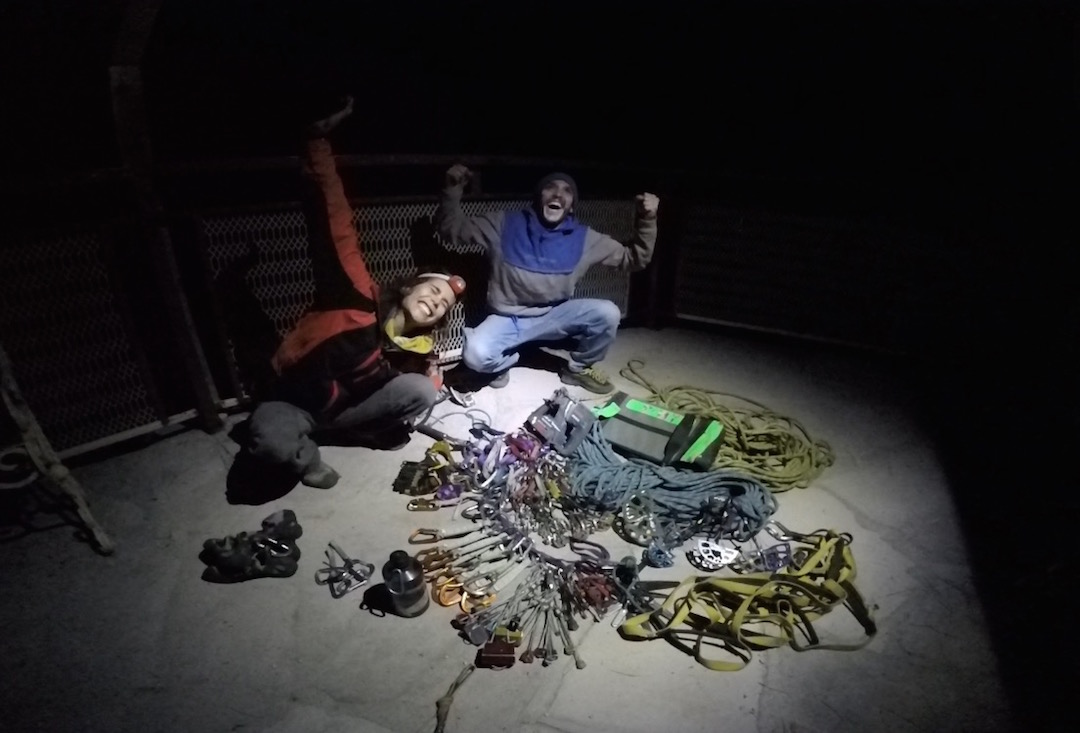Mirador Wall, Rarámuri Southwest
Mexico, Chihuahua, Parque Nacional Cascada de Basaseachi

For some years I have been captivated by the many big walls in Basaseachi Falls National Park. At 2,700’, El Gigante is the biggest vertical wall in Mexico, and then there’s Piedra Bolada, with the highest seasonal waterfall (1,500’), and Basaseachi Falls, with a 1,000’ wall. Besides those important formations, Candameña Canyon offers an infinite number of opportunities to climb new lines, with vertical cliffs lining a canyon that runs more than five miles from Basaseachi Falls to El Gigante. At the end of February, my goal was a vertical wall in front of Basaseachi Falls.
This cliff, which we called Mirador Wall, is right below a viewpoint (Mirador III) overlooking the waterfall, so the exit from the climb wouldn’t be a problem. From our car it was less than two hours’ walk into Candameña Canyon to reach the base, so it is less complicated to reach than other walls in the national park.
My partner for this climb was Larissa Arce, a really good climber from Chihuahua. She has huge motivation for climbing and is completely devoted to her passion. She hadn’t done a big wall before, but her attitude, energy, and mind for learning were incredible—all important things for our ascent. On February 19, we traveled from Chihuahua to Basaseachi and camped near the home of our good friends Don Chuy and Doña Calita, who served us some delicious food before we left for the climb. We carried about 140 pounds of equipment and food to the base of the Miraror Wall in two stages, collecting water at a natural spring, and established a camp in a small cave protected from rockfall.
Over the next three days we fixed ropes to a height of 409’, at the top of pitch four. We were happy to find cracks right from the start and move at a good pace. On the fourth day of our expedition we decided to take everything up the wall and continue in capsule style.

On pitch five the route was not obvious. We began by moving into a corner system, but this was a bad guess because almost all of the dihedrals had blind cracks that couldn’t be protected. We ended up doing some aid climbing with hooks and runouts. This slowed our climb to the point that we managed only 90’ a day. On pitch sixth we aided a traverse to the right, aiming to find some cracks, but didn’t find any. So for pitch seven, we continued zigzagging up the wall, with Larissa leading her first complete aid pitch, placing micro-nuts and doing some hook moves. Pitch eight was exactly the same, climbing though some vertical and overhanging passages, with protection only from small cams in pockets. We used only one knifeblade piton and three protection bolts on the entire route, along with bolted anchors.
By the top of the eighth pitch, 750’ above the base, it had been four days since we began camping on the wall. Our only motivation was that we were still going up—little by little, but still climbing. It appeared that with only 160’ more climbing we would reach fourth-class terrain that would take us to Mirador III.
The last day on the wall was long, frustrating, and mentally challenging. We started early, and after a quick breakfast we packed the haul bags, climbed up our fixed ropes, and hauled everything to the top of the eighth pitch. It was past noon, and we were ready to climb the last part and get out of there. Larissa led 130’ to the end of the technical climbing. But right after this success, our tagline got caught on some bushes, and it took us more than three hours to free the rope, bolt the anchors of pitch nine, and haul the gear to the top of the wall. Now it was almost dark, but we still had good batteries for our headlamps to help us find our way to the viewpoint, which we finally reached with all of the gear at 10 p.m. Our bodies were exhausted and starving, and it was a cold night, but we were very happy to be there.
After working on the route for 10 days, and living five of those days on the wall, we had completed the first ascent of Mirador Wall by the route Rarámuri Southwest (1,000’, VI 5.10c (6a+) A2), which we named in honor of the Rarámuri people. The wall has a long climbing season because there is a lot of shade, with only some hours of sun before sunset. It could be repeated in two to three days by quick aid climbers, now that the loose rock has been cleaned.
Tiny Almada, Mexico









